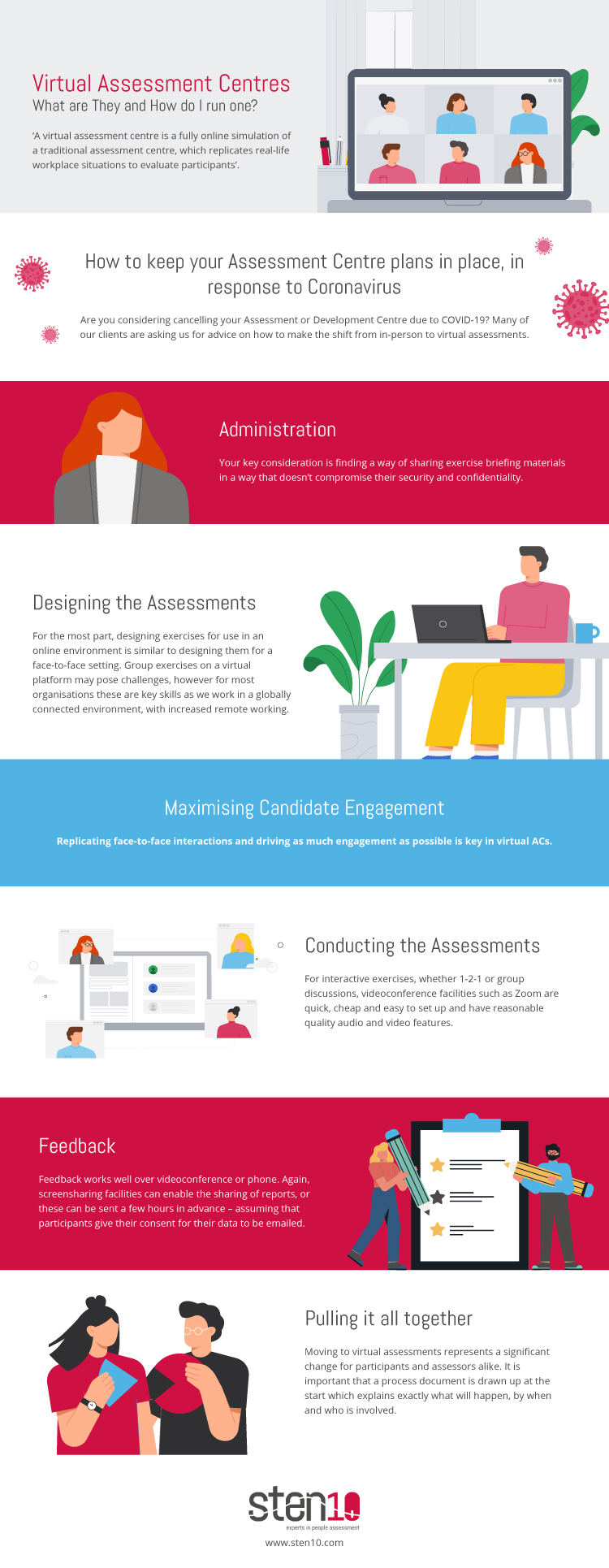‘A virtual assessment centre is a fully online simulation of a traditional assessment centre, which replicates real-life workplace situations to evaluate participants' skills and behaviours in a controlled environment to make crucial decisions about hiring, developing and identifying organizational talent’.
In times such as these, many organisations have understandably opted to move their assessments online. It is important therefore, to look at perhaps the most important aspect of virtual Assessment Centres (ACs): administration and management. This blog will focus on several key aspects of virtual assessment centres and will highlight what we must keep in mind in order to keep them running smoothly.
Challenges of transitioning across to fully virtual ACs include the mapping, planning, and coordinating of the many different interactions that need to occur between candidates and assessors. This allows for a seamless experience and the reliable gathering of data to facilitate the purpose of the AC, whether this be for recruitment, development, promotion or restructuring. This is predominantly where bespoke checklists, design protocols and management briefs come into play, which assist in the smooth running of ACs.
How to keep your Assessment Centre plans in place, in response to Coronavirus
Are you considering cancelling your Assessment or Development Centre due to COVID-19? Many of our clients are asking us for advice on how to make the shift from in-person to virtual assessments. If you already have your assessment materials designed and are not sure what to do next, here are some tips to help with the transition.
Administration
Your key consideration is finding a way of sharing exercise briefing materials in a way that doesn’t compromise their security and confidentiality. A file sharing service that is time limited (i.e. only allows the briefing materials to be viewed for a certain period) would work well here. This feature is available in Google Drive (see here: https://www.labnol.org/internet/auto-expire-google-drive-links/27509/).
Alternatively, you could consider a dedicated platform such as www.topscoretech.com. The security of AC content is achieved by sharing documents within the platform itself so that they cannot be downloaded.
Whichever format you choose, there should be a documented administrative procedure and guidelines detailing links to documents, the parameters of documents’ timed access and login details/passwords.
Administration should also include additional time for reading materials for those who need it (i.e. those with learning disabilities) with correspondingly amended timed access.

Designing the Assessments
For the most part, designing exercises for use in an online environment is similar to designing them for a face-to-face setting. Group exercises on a virtual platform may pose challenges, however for most organisations these are key skills as we work in a globally connected environment, with increased remote working. Group exercises and role-plays can be run on virtual platforms, with screen-sharing used to share materials. Typically, candidates will work with their cameras on whilst assessors join without cameras and on mute – allowing them to observe the interaction without disturbing the group dynamics.
Interviews and presentations can be digitalised with ease. Indeed, they can present further insight into participants’ facility with software tools (as opposed to using flipcharts in physical presentations for example).
However, it is important that we recognise that the virtual format does not take away from the emotional and cognitive load that candidates experience when they are physically at an AC. As such, the following areas should be considered to ensure that candidates are not overwhelmed:
- While we would certainly run a day-long AC, we may need to allocate more time for each component.
- Some organisations might want to consider splitting the AC up into two days:
- Day 1 – a more informal guided tour of the process, comprised of preparatory advice, tips on interacting on the AC day, digital formats being used, material check-ins, assessor briefing, candidate briefing, day-in-the-life introductions, expectations, administration, and focal points to reach out to in case of technical and content difficulties.
- Day 2 – would be the AC day in which all parties would participate with less confusion and/or apprehension.
- Take technological comfort-levels into account. Not everyone will be familiar with using Zoom, Skype, and other similar platforms, especially in an AC environment. Exploring different digital mediums and checking with the candidate on their comfort with each is key.
Maximising Candidate Engagement
Replicating face-to-face interactions and driving as much engagement as possible is key in virtual ACs. This can be achieved through:
- Designing virtual icebreakers and ‘lunch-break’ forums
- Creating ‘day in the life’ content through filmed SJTs, video introductions, virtual tours etc.
- Designing a ‘script’ about the virtual candidate experience – what to expect, and what might feel odd at first
- Including more conversational prompts from assessors i.e. acknowledging/confirming we have heard what candidates have said
- Providing a dedicated mediator to facilitate group discussions if people’s points are overlapping
- Allocating more time for discussion i.e. informally, between candidates and the administrator
- Allocating appropriate time to manage any technological lags and candidate access issues
Conducting the Assessments
For interactive exercises, whether 1-2-1 or group discussions, videoconference facilities such as Zoom are quick, cheap and easy to set up and have reasonable quality audio and video features. Almost all phones and laptops have inbuilt cameras now, so technology shouldn’t be a barrier. Make sure that the participants in the exercise (i.e. the individual candidate(s) and role player(s)) have their cameras on, but that the assessors have theirs OFF so as not to distract the participants. Also, ensure you ask everyone in advance to base themselves in a quiet place, free from distractions or loud noises. Ideally, people should be asked to use headsets and microphones for the best audio quality.
In a group exercise, if ‘new information’ needs to be shared partway through the exercise then platforms like Zoom have a ‘screen share’ function, which the administrator can use to announce ‘breaking news’ or introduce new instructions partway through.
If a written response is required to materials, then you can simply email the response template to participants in advance and ask them to email back to a set email address, by a set time, from which responses can then be sent on to assessors.
As an alternative consideration, you could decide to change the format of your exercises for ease of administration: for example, a group discussion could be turned into a 1-2-1 discussion; or a presentation could be turned into a written exercise. You may not be able to measure the same competencies, but it may make the administration more feasible and you can focus on those competencies or strengths that ARE able to be assessed remotely. You also have the option of moving to a virtual assessment centre platform to administer exercises, although this will require a fair amount of customising of your existing content to achieve.
Integration / Wash-Up Session
Again, using videoconference facilities for this, along with the Administrator screen-sharing the integration matrix and completing it as the discussion progresses is perfectly workable. Make sure you schedule in regular breaks if it’s a long session so that the assessors remain focused.
Timetabling
You have a choice here: stick to the timetable as-is, or flex it so that the exercises occur across multiple days. The latter option may help with participants and / or assessors who require more flexible working hours to look after dependents, however, this does run the risk of participants doing additional research on the assessment topics, collaborating ‘off-line’ or asking others for advice – so it may not be appropriate in all contexts.
Assessor Training
Transform your assessor training into a webinar format, with accompanying interactive quiz elements to test their knowledge of the materials and process. In order to test assessment skills, you can either show a pre-recorded video of participants completing an exercise; or run a live role play over videoconference and ask assessors to rate it. Asking assessors to then compare their ratings and the evidence they used to inform these can help them to ‘benchmark’ expectations and also feel more of a cohesive assessor team. Comparing the spread of scores can also help you to identify where any leniency or harshness bias may be occurring.
Feedback
Feedback works well over videoconference or phone. Again, screensharing facilities can enable the sharing of reports, or these can be sent a few hours in advance – assuming that participants give their consent for their data to be emailed.
For virtual feedback to be most effective, schedule a little more time than usual at the start for rapport-building and explaining the logistics of the session. Ensure that both participant and feedback giver are in a private space where the feedback won’t be overheard and encourage the participant to take notes and regularly summarise the feedback heard.
Pulling it all together
Moving to virtual assessments represents a significant change for participants and assessors alike. It is important that a process document is drawn up at the start which explains exactly what will happen, by when and who is involved. This should be sent to everyone involved and relevant webinar briefings held so that any questions can be addressed.
You also need to consider whether remote assessments require any changes in your data handling processes – especially in light of GDPR. Making use of an online data-sharing portal (such as Box) can be a better solution than having everything emailed back and forth. Consider password-protecting documents and/or encrypting files.
Conclusions
Each aspect of a virtual assessment centre, whether physical or virtual, links back to a meticulously considered design. Now more than ever, it is critical to focus on our management of the candidate experience and administration of the assessment process.
While the decision to go virtual may have been made for us, there are key learnings that are likely to continue to be the ‘new normal,’ whether we remain with the virtual format or revert to in-person assessments in due course.
If you would like help with moving to a virtual assessment process, we would be delighted to discuss what plans will work best for you. Call us for a no-obligation chat on 0208 090 0147 or email hello@sten10.com.



